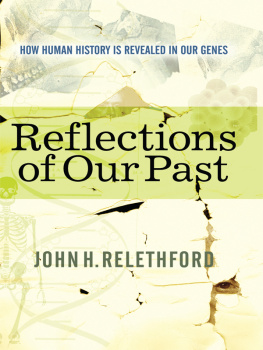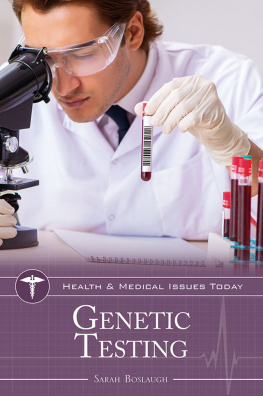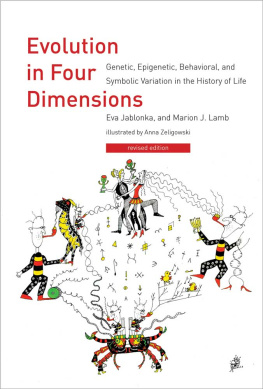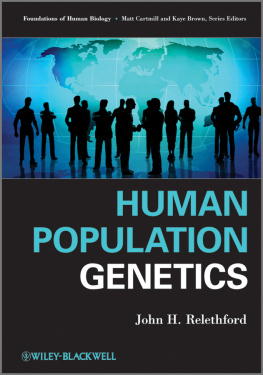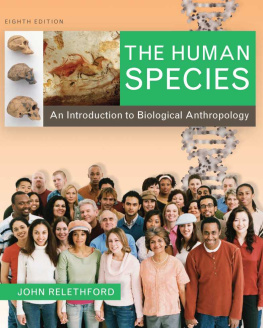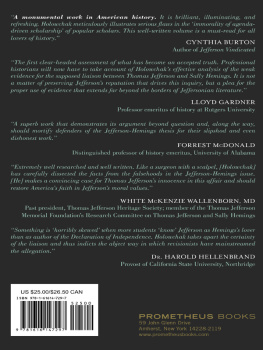REFLECTIONS of OUR PAST
REFLECTIONS
of OUR PAST
How Human History
Is Revealed in Our Genes
John H. Relethford
All rights reserved. Printed in the United States of America. No part of this publication may be reproduced or transmitted in any form or by any means, electronic or mechanical, including photocopy, recording, or any information storage and retrieval system, without permission in writing from the publisher.
Copyright 2003 by Westview Press, A Member of the Perseus Books Group
Westview Press books are available at special discounts for bulk purchases in the United States by corporations, institutions, and other organizations. For more information, please contact the Special Markets Department at the Perseus Books Group, 11 Cambridge Center, Cambridge MA 02142, or call (617) 252-5298 or (800) 255-1514 or email .
Hardcover edition first published in 2003 in the United States of America by Westview Press, 5500 Central Avenue, Boulder, Colorado 803012877, and in the United Kingdom by Westview Press, 12 Hids Copse Road, Cumnor Hill, Oxford OX2 9JJ
Paperback edition first published in 2004 by Westview Press.
Find us on the World Wide Web at www.westviewpress.com
Set in 10.5 point Galliard by the Perseus Books Group
A Cataloging-in-Publication data record for this book is available from the Library of Congress.
ISBN 0-8133-4259-7 (paperback)
eBook ISBN: 9780786741793
The paper used in this publication meets the requirements of the American National Standard for Permanence of Paper for Printed Library Materials Z39.48-1984.
10 9 8 7 6 5 4 3 2 1
To my teachers and students,
for their inspiration,
And to my wife, Hollie, and
my sons, David, Ben, and Zane,
for their love
A TIME MACHINE
Ive often wished I had a time machine.
Not a machine that allowed me to travel through time (although Ive entertained that fantasy as well), but some device that would allow me to peer into the past to see what happened. This desire emerged from reading time travel stories in comic books and science fiction novels as a youth and was deepened by my professional interest in the history of the human species. Where did we come from? Where and when did our ancestors live? When did humans first inhabit different parts of the world? These and other questions form the framework of much of my research. Because of this interest in the past, these questions are essentially historical in nature.
When you think of historical research, what types of information come to mind? There are a number of ways to obtain information from the past. For very recent times, we have the technology to actually see or hear past events that have been recorded on video and sound recorders. For earlier times, we have images from photographs, paintings and drawings, and sculpture. Written records, ranging from official documents to memoirs to diaries provide another window on history. Oral histories, including genealogies, stories, and legends, provide even more information.
There is an obvious limit to these methods. Video and audio technologies are recent inventions and cannot be used to see or hear events earlier in history. Written records are obviously limited to the time since humans developed writing systems (within the past 10,000 years at most). Oral histories are often subject to rapid change over time, as facts become myths and vice versa. To probe deeper and more fully into the past, we rely on inferences drawn from archaeological evidence, hoping to extract information about where, when, and how people lived from the remains of their past societies.
There is another source of information about the past: the genes that we all carry inside of us. Although we may lack direct historical or prehistorical documentation of past events, a record is present in our genes. Each of us carries pieces of history in our genes. This book is about the search for human history not in documents or records, or even in ancient archaeological remains, but in the genetic material that we all carry. What can genetics tell us about our past?
This book examines how scientists use genetic information to reveal reflections of our past. My purpose is to provide the reader with information on not only what geneticists and anthropologists can tell about our past from genetic data but also how they do this. Genetics provides us with some interesting answers to our ancestry, and this book summarizes some of this exciting research.
Ive structured this book in terms of a chronological journey, starting millions of years in the past with the origin of the first humanlike creatures and working forward to the present in each chapter. Not every time period or part of the world is covered; instead, the purpose is to give you an idea of some key events at different parts of our species past. My goal here is to provide a broad picture of human history and prehistory illustrated by specific examples from different times and places. Some of the stops along the way include the following:
- Who are our closest living relatives, and when did we diverge along a different evolutionary path? (67 million years ago)
- When and where did modern humans first appear, and how are they related to other early humans? (130,0002 million years ago)
- What happened to the Neandertals? (28,000150,000 years ago)
- Where and when did the first Americans come from? (15,00020,000 years ago)
- How did farming spread across Europe in prehistoric times? (6,000 10,000 years ago)
- When did humans first voyage into the Pacific, and where did they come from? (3,500 to 6,000 years ago)
- What is the genetic history of the Jews? (4,000 years ago)
- What was the genetic impact of the Viking invasions of Ireland? (1,200 years ago)
- What are the genetic roots of African Americans? (400 years ago)
Although my childhood dream of a time machine remains unfulfilled, the developments in genetics over the past century have provided another way to glimpse some of the history of our species.
I thank all of my colleagues who over the years have worked with me and helped me in my career. I am particularly grateful to those who have had the greatest impact on my research and professional development John Blangero, Mike Crawford, Henry Harpending, Lyle Konigsberg, Frank Lees, Dick Wilkinson, and Milford Wolpoff.
I am very grateful to my sponsoring editor, Karl Yambert, for his assistance throughout all stages of this project. Karl responded with enthusiasm to my early, rather poorly conceived ideas for this book and helped me transform these ideas into reality. He also suggested the analogy of the palimpsest used in . I also thank Barbara Greer, project editor, for her professionalism and attention to details, and Jennifer Swearingen, copy editor, for a wonderful job in straightening out my tangled prose. I am also grateful to Tad Schurr for his review and recommendations.
JOHN H. RELETHFORD
December 2002
ONE
The History in Our Genes
I probably shouldnt admit this, but I spent a fair amount of time watching television while in graduate school.

